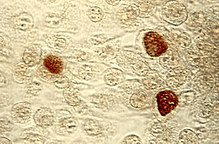
Chlamydia trachomatis

Chlamydia trachomatis (/kləˈmɪdiə trəˈkoʊmətɪs/), commonly known as chlamydia, is a bacterium that can replicate only in human cells. It causes chlamydia, which can manifest in various ways, including: trachoma, lymphogranuloma venereum, nongonococcal urethritis, cervicitis, salpingitis, pelvic inflammatory disease. C. trachomatis is the most common infectious cause of blindness and the most common sexually transmitted bacterium. Different types of C. trachomatis cause different diseases. The most common strains cause disease in the genital tract, while other strains cause disease in the eye or lymph nodes. Like other Chlamydia species, the C. trachomatis life cycle consists of two morphologically distinct life stages: elementary bodies and reticulate bodies. Elementary bodies are spore-like and infectious, whereas reticulate bodies are the replicative stage and are seen only within host cells. Chlamydia trachomatis is a gram-negative bacterium that can replicate only within a host cell. Over the course of the C. trachomatis life cycle, the bacteria take on two distinct forms. Elementary bodies are 200 to 400 nanometers across, and are surrounded by a rigid cell wall that allows them to survive outside of a host cell. This form can initiate a new infection if it comes into contact with a susceptible host cell. Reticulate bodies are 600 to 1500 nanometers across, and are found only within host cells. Neither form is motile. The C. trachomatis genome is substantially smaller than that of many other bacteria at approximately 1.04 megabases, encoding approximately 900 genes. A number of important metabolic functions are not encoded in the C. trachomatis genome, and instead are likely scavenged from the host cell. In addition to the chromosome that contains most of the genome, nearly all C. trachomatis strains carry a 7.5 kilobase plasmid that contains 8 genes. The role of this plasmid is unknown, though strains without the plasmid have been isolated, suggesting it is not required for survival of the bacterium. Like other Chlamydia species, C. trachomatis has a life cycle consisting of two morphologically distinct forms. First, C. trachomatis attaches to a new host cell as a small spore-like form called the elementary body. The elementary body enters the host cell, surrounded by a host vacuole, called an inclusion. Within the inclusion, C. trachomatis transforms into a larger, more metabolically active form called the reticulate body. The reticulate body substantially modifies the inclusion, making it a more hospitable environment for rapid replication of the bacteria, which occurs over the following 30 to 72 hours. The massive number of intracellular bacteria then transition back to resistant elementary bodies, before causing the cell to rupture and being released into the environment. These new elementary bodies are then shed in the semen or released from epithelial cells of the female genital tract, and attach to new host cells. C. trachomatis are bacteria in the genus Chlamydia, a group of obligate intracellular parasites of eukaryotic cells. Chlamydial cells cannot carry out energy metabolism and they lack biosynthetic pathways. C. trachomatis strains are generally divided into three biovars based on the type of disease they cause. These are further subdivided into several serovars based on surface antigens recognized by the immune system. Serovars A through C cause trachoma, which is the world's leading cause of preventable infectious blindness. Serovars D through K infect the genital tract, causing pelvic inflammatory disease, ectopic pregnancies, and infertility. Serovars L1 through L3 cause an invasive infection of the lymph nodes near the genitals, called lymphogranuloma venereum. C. trachomatis is thought to have diverged from other Chlamydia species around 6 million years ago. This genus contains a total of nine species: C. trachomatis, C. muridarum, C. pneumoniae, C. pecorum, C. suis, C. abortus, C. felis, C. caviae, C. psittaci. The closest relative to C. trachomatis is C. muridarum, which infects mice. C. trachomatis along with C. pneumoniae have been found to infect humans to a greater extent. C. trachomatis exclusively infects human beings. C. pneumoniae is found to also infect horses, marsupials, and frogs. Some of the other species can have a considerable impact on human health due to their known zoonotic transmission.
